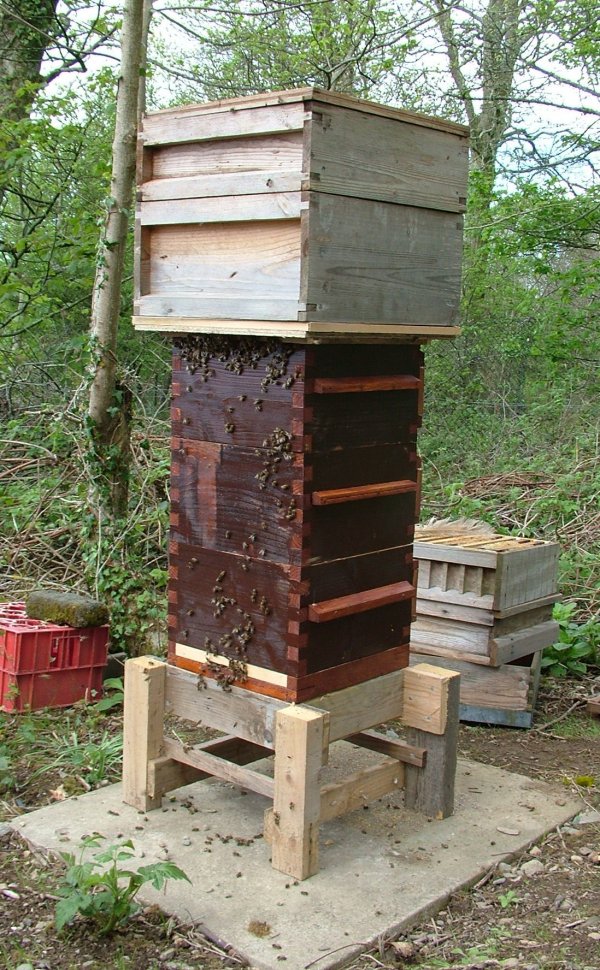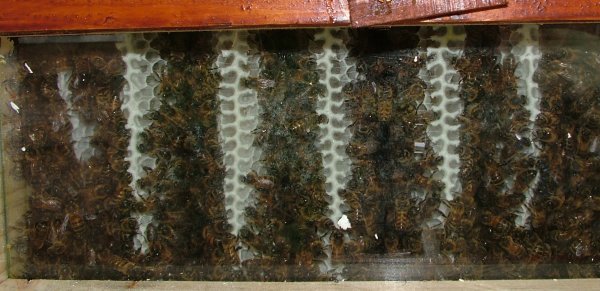
David Heaf's Warré hive experiment
Diary for 2007 -- the first year
April/May 2007 -- The author's first Warré hives are populated
Two of the author's British 'National' hives were preparing to swarm on 26 April and 5 May 2007, and were artificially swarmed into Warré hives 1 and Warré 2 respectively without searching for the queen and using the following method. The Warré roof and quilt were removed and an aluminium funnel designed to receive bees shaken or brushed from National hive frames was placed on the top box. Bees were shaken from each brood frame of the hive to be swarmed and when clean of bees the frame was placed in a fresh brood box. Bees on any frames with queen cells with larvae were brushed, not shaken, into the Warré hive. When all 11 frames were clear of bees, the funnel was shaken free of bees, the bees on the top were smoked down and a Warré-to-National adapter board was placed on the top Warré box. A queen excluder was placed on this followed by the National box containing brood, its super and the crown board. Many bees took to the air and shortly after this operation almost the entire front of the Warré was covered in bees. About 10 minutes later it was as shown in the photo below.

The brood in the National hive was left on the Warré for two hours to repopulate the combs with nurse bees. It was then moved onto its own stand a metre from the Warré and facing the same way. The Warré was given a feed in a Warré-sized Ashforth-type feeder placed on the brood box. The feed was 900 g honey (from the same apiary) diluted 2 parts honey to 1 part water by weight. The quilt and roof were placed on the feeder which was removed when empty. Six days later the brood in the National was moved in the early afternoon to another site in the apiary leaving the flying bees to strengthen the Warré.
By 7 May 2007, 10 days later, the top box of Warré 1 viewed through its window was as shown in the following photo:

Six combs have been drawn wide enough to be touching the window glass and have been extended downwards to or below the window sill, i.e. at least 160 mm from the top bars. A seventh comb is occasionally visible as the bees move around, and the eighth, the smallest, is obscured by bees.
By 19 May 2007, seven combs of Warré 1 top box were developed to their full widths against the window, down to about 25 mm from the sill. Most of the end cells were filled with honey and cells further in were capped. In box 2, five combs were visible, the longest extending half way to the floor of its chamber. For about a fortnight, the weather had been cool, wet, often overcast and windy. In Warré 2, seven combs extended to below the window sill and the eighth, still quite narrow and thin, was extended to about 100 mm below the top bars. A slightly slower initial development of Warré 2 compared with Warré 1 is probably attributable to the poorer weather since Warré 2 was populated.
The Warré hives were visited by the author and Jean-François Dardenne (http://ruche-warre.levillage.org) who advised removing the third (bottom) brood box until the brood had developed to near the bottom of the second box. The rationale is that the bees have less distance to climb after entering the hive. This was done for both Warré hives.
August 2007
Warré hive 1 is a strong colony occupying three boxes and foraging well. Warré 2, after a good start and drawing one and three quarters boxes of comb, greatly slowed down. By 14 July Warré 2 had seven advanced queen cells, one sealed, in the top box close to the window. On 19 July the cells were hatched or opened at the side and new queen was seen stinging the side of an unhatched cell, helped by workers. This hive superseded. Foraging from it was less than half that of Warré 1 by early August. A further four Warré hives were populated. The details are summarised in the following table:
| Hive no. | Date | How populated | Number of boxes of comb (August) |
| 1 | 27 April | Ordinary artificial swarm | 2 ¾ |
| 2 | 5 May | Ordinary artificial swarm | 1 ¾ |
| 3 | 3 June | Taranov artificial swarm | ¾ |
| 4 | 7 June | Natural swarm | 1 |
| 5 | 19 June | Natural swarm | ¾ |
| 6 | 11 July | Natural swarm | ¾ |
Hives 1, 4, 5 and 6 are still drawing comb. It remains to be seen whether they will build up comb and stores to winter well. Warré in Beekeeping For All recommends that the colony should winter on two boxes of drawn comb and 12 kg stores. In mid August the important nectar flows that remain in the immediate locality are Himalayan balsam (Impatiens glandulifera), Japanese knotweed (Reynoutria japonica) and ivy (Hedera helix). The latter provides nectar and pollen into early November.
Warré reports that a healthy 2 kg swarm will fill two boxes with comb in 15-20 days, if hived at the start of the main nectar flow. Hive 1 did not receive its third box until 24 May, i.e. a week later than expected, by which time the second was almost full. Development seemed relatively rapid in the warm weather at the end of April and early May but since then it has been relatively wet and cool with rain on 50 days to date. This has more severely affected the hives populated since April. The experiment will not be complete until the colonies have overwintered and gone through at least one full season.
2 October 2007
All hives were fitted with mouse guards and hefted in preparation for wintering.
Hefting was done by weighing each side of the boxes containing comb using a 60-pound spring-balance suspended from a sash cramp (weighing device). The cramp screw was turned so that the box, just lifted off its seating. The weights from each side were combined. Boxes to be hefted were freed with a hive tool and if necessary rotated slightly in both directions to break any comb bridges to the box below. The stores were estimated by subtracting weights of the box, the top bars, the comb and an estimate for the bees. The results are shown in the following table.
| Hive | Boxes of comb | Stores (pounds) |
| 1 | 2 ¾ | 24.6 |
| 2 | 1 ¾ | 3.8 |
| 3 | ¾ | 18.6 |
| 4 | 1 ½ | 26.8 |
| 5 | ¾ | 8.3 |
| 6 | 1 | 18.3 |
Warré recommends leaving 12 kg. stores for overwintering. Only two hives approximated to this, namely 1 and 4. However, hive 3 and 6 had over 18 pounds, which is more than the amount on which several of the author's National (framed) hives overwintered successfully from 2006 to 2007. Furthermore, in the week since hefting, the ivy (Hedera helix) flow was vigorous and even Himalayan balsam (Impatiens glandulifera) was still supplying nectar. The author's National hives generally gain weight in October. Hives 2 and 5 almost certainly have too low a weight of stores to survive the winter. It was hoped that hive 1, with comb filling nearly 3 boxes would yield honey for harvest. However, when this box was removed, the top edge of the brood nest extended into two of the combs. It was therefore left intact. Later calculation also confirmed that the total stores were anyway below the amount that Warré recommended for overwintering.
It is interesting to note that the colony that performed best, number 4, was a natural swarm. It put on more weight than the first colony which was hived 6 weeks earlier. Also, the last colony to be hived, on 11 July, has done relatively well too. This was also a natural swarm.
The author has abandoned swarm control in favour of catching swarms. A high proportion are caught in bait hives placed not far from the apiary and transferred on the evening of arrival to a Warré hive. (see 'Hiving a swarm from a bait hive into a Warré')